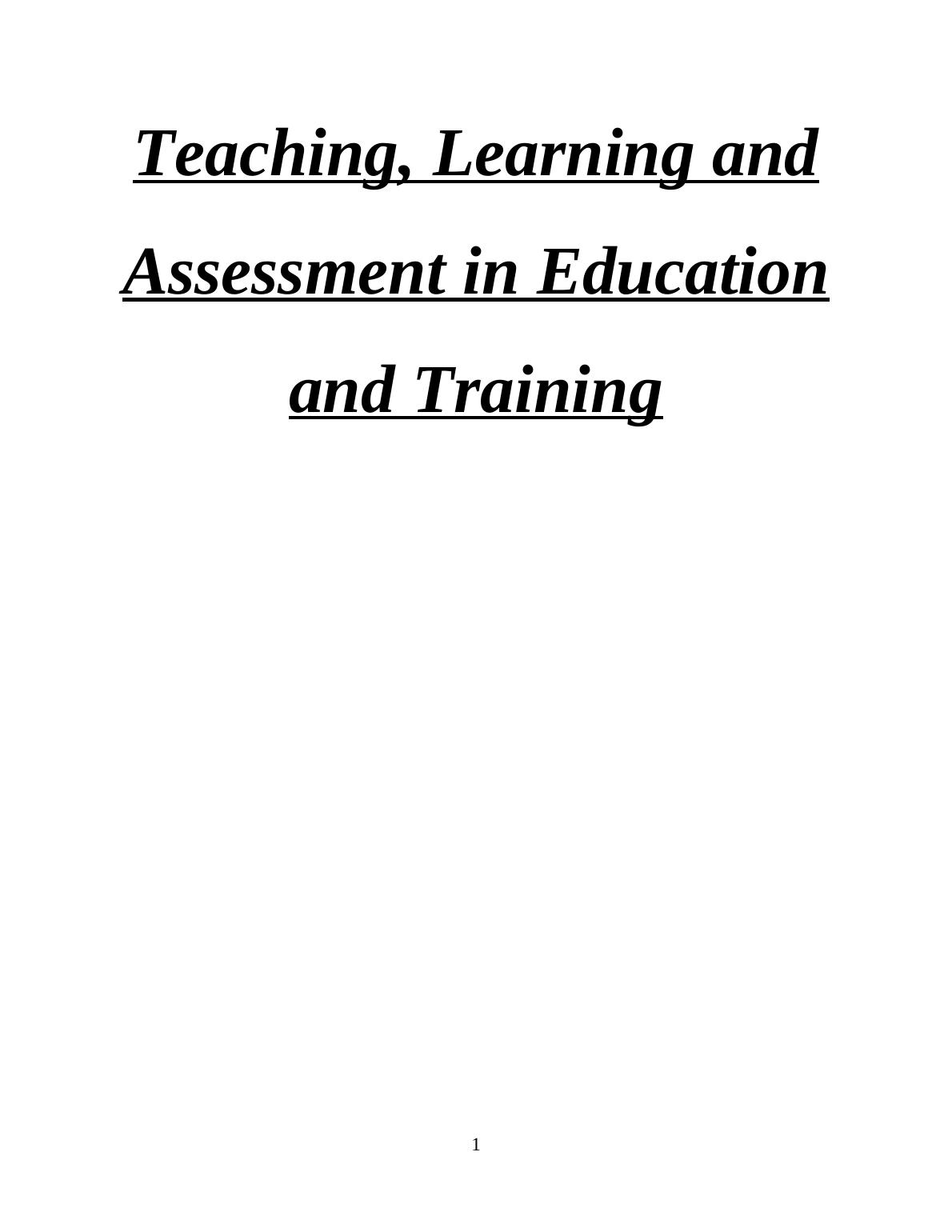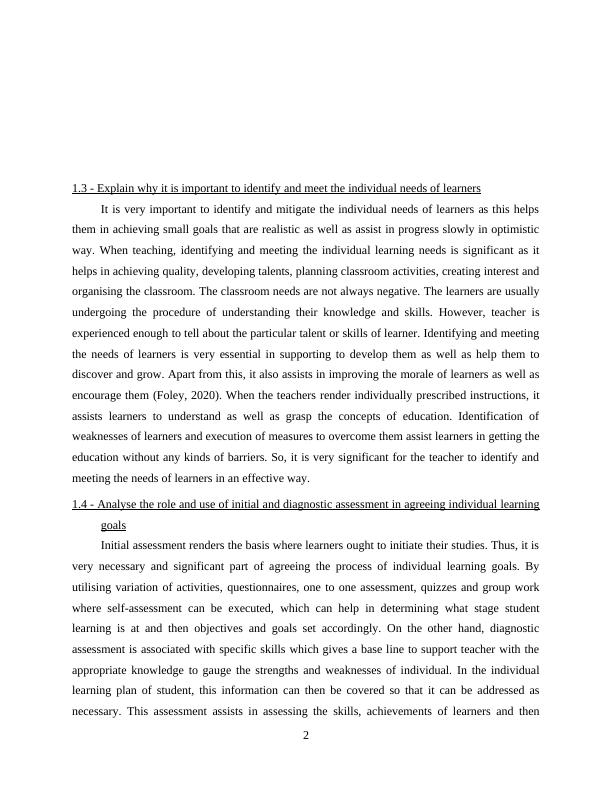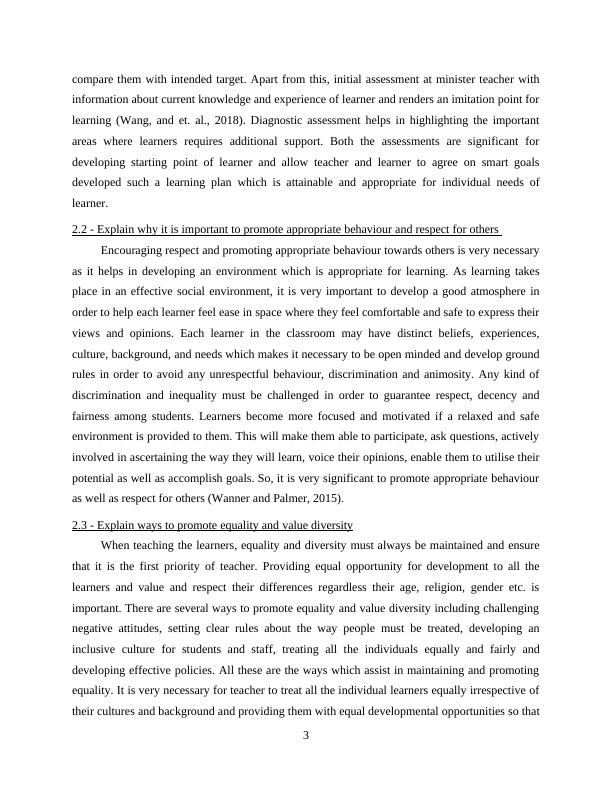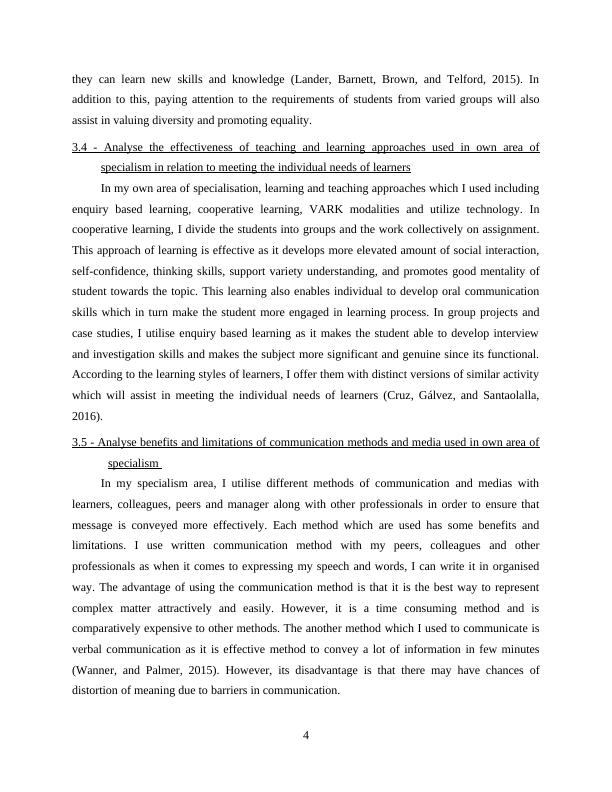Teaching, learning and assessment in education and training
14 Pages5475 Words61 Views
Added on 2023-01-06
About This Document
Note:- For each question, write only 15 lines (200 words).
For each unit could you please add two references on any questions
Avoid using big words please, and use simple words.
Teaching, learning and assessment in education and training
Added on 2023-01-06
ShareRelated Documents
Teaching, Learning and
Assessment in Education
and Training
1
Assessment in Education
and Training
1

1.3 - Explain why it is important to identify and meet the individual needs of learners
It is very important to identify and mitigate the individual needs of learners as this helps
them in achieving small goals that are realistic as well as assist in progress slowly in optimistic
way. When teaching, identifying and meeting the individual learning needs is significant as it
helps in achieving quality, developing talents, planning classroom activities, creating interest and
organising the classroom. The classroom needs are not always negative. The learners are usually
undergoing the procedure of understanding their knowledge and skills. However, teacher is
experienced enough to tell about the particular talent or skills of learner. Identifying and meeting
the needs of learners is very essential in supporting to develop them as well as help them to
discover and grow. Apart from this, it also assists in improving the morale of learners as well as
encourage them (Foley, 2020). When the teachers render individually prescribed instructions, it
assists learners to understand as well as grasp the concepts of education. Identification of
weaknesses of learners and execution of measures to overcome them assist learners in getting the
education without any kinds of barriers. So, it is very significant for the teacher to identify and
meeting the needs of learners in an effective way.
1.4 - Analyse the role and use of initial and diagnostic assessment in agreeing individual learning
goals
Initial assessment renders the basis where learners ought to initiate their studies. Thus, it is
very necessary and significant part of agreeing the process of individual learning goals. By
utilising variation of activities, questionnaires, one to one assessment, quizzes and group work
where self-assessment can be executed, which can help in determining what stage student
learning is at and then objectives and goals set accordingly. On the other hand, diagnostic
assessment is associated with specific skills which gives a base line to support teacher with the
appropriate knowledge to gauge the strengths and weaknesses of individual. In the individual
learning plan of student, this information can then be covered so that it can be addressed as
necessary. This assessment assists in assessing the skills, achievements of learners and then
2
It is very important to identify and mitigate the individual needs of learners as this helps
them in achieving small goals that are realistic as well as assist in progress slowly in optimistic
way. When teaching, identifying and meeting the individual learning needs is significant as it
helps in achieving quality, developing talents, planning classroom activities, creating interest and
organising the classroom. The classroom needs are not always negative. The learners are usually
undergoing the procedure of understanding their knowledge and skills. However, teacher is
experienced enough to tell about the particular talent or skills of learner. Identifying and meeting
the needs of learners is very essential in supporting to develop them as well as help them to
discover and grow. Apart from this, it also assists in improving the morale of learners as well as
encourage them (Foley, 2020). When the teachers render individually prescribed instructions, it
assists learners to understand as well as grasp the concepts of education. Identification of
weaknesses of learners and execution of measures to overcome them assist learners in getting the
education without any kinds of barriers. So, it is very significant for the teacher to identify and
meeting the needs of learners in an effective way.
1.4 - Analyse the role and use of initial and diagnostic assessment in agreeing individual learning
goals
Initial assessment renders the basis where learners ought to initiate their studies. Thus, it is
very necessary and significant part of agreeing the process of individual learning goals. By
utilising variation of activities, questionnaires, one to one assessment, quizzes and group work
where self-assessment can be executed, which can help in determining what stage student
learning is at and then objectives and goals set accordingly. On the other hand, diagnostic
assessment is associated with specific skills which gives a base line to support teacher with the
appropriate knowledge to gauge the strengths and weaknesses of individual. In the individual
learning plan of student, this information can then be covered so that it can be addressed as
necessary. This assessment assists in assessing the skills, achievements of learners and then
2

compare them with intended target. Apart from this, initial assessment at minister teacher with
information about current knowledge and experience of learner and renders an imitation point for
learning (Wang, and et. al., 2018). Diagnostic assessment helps in highlighting the important
areas where learners requires additional support. Both the assessments are significant for
developing starting point of learner and allow teacher and learner to agree on smart goals
developed such a learning plan which is attainable and appropriate for individual needs of
learner.
2.2 - Explain why it is important to promote appropriate behaviour and respect for others
Encouraging respect and promoting appropriate behaviour towards others is very necessary
as it helps in developing an environment which is appropriate for learning. As learning takes
place in an effective social environment, it is very important to develop a good atmosphere in
order to help each learner feel ease in space where they feel comfortable and safe to express their
views and opinions. Each learner in the classroom may have distinct beliefs, experiences,
culture, background, and needs which makes it necessary to be open minded and develop ground
rules in order to avoid any unrespectful behaviour, discrimination and animosity. Any kind of
discrimination and inequality must be challenged in order to guarantee respect, decency and
fairness among students. Learners become more focused and motivated if a relaxed and safe
environment is provided to them. This will make them able to participate, ask questions, actively
involved in ascertaining the way they will learn, voice their opinions, enable them to utilise their
potential as well as accomplish goals. So, it is very significant to promote appropriate behaviour
as well as respect for others (Wanner and Palmer, 2015).
2.3 - Explain ways to promote equality and value diversity
When teaching the learners, equality and diversity must always be maintained and ensure
that it is the first priority of teacher. Providing equal opportunity for development to all the
learners and value and respect their differences regardless their age, religion, gender etc. is
important. There are several ways to promote equality and value diversity including challenging
negative attitudes, setting clear rules about the way people must be treated, developing an
inclusive culture for students and staff, treating all the individuals equally and fairly and
developing effective policies. All these are the ways which assist in maintaining and promoting
equality. It is very necessary for teacher to treat all the individual learners equally irrespective of
their cultures and background and providing them with equal developmental opportunities so that
3
information about current knowledge and experience of learner and renders an imitation point for
learning (Wang, and et. al., 2018). Diagnostic assessment helps in highlighting the important
areas where learners requires additional support. Both the assessments are significant for
developing starting point of learner and allow teacher and learner to agree on smart goals
developed such a learning plan which is attainable and appropriate for individual needs of
learner.
2.2 - Explain why it is important to promote appropriate behaviour and respect for others
Encouraging respect and promoting appropriate behaviour towards others is very necessary
as it helps in developing an environment which is appropriate for learning. As learning takes
place in an effective social environment, it is very important to develop a good atmosphere in
order to help each learner feel ease in space where they feel comfortable and safe to express their
views and opinions. Each learner in the classroom may have distinct beliefs, experiences,
culture, background, and needs which makes it necessary to be open minded and develop ground
rules in order to avoid any unrespectful behaviour, discrimination and animosity. Any kind of
discrimination and inequality must be challenged in order to guarantee respect, decency and
fairness among students. Learners become more focused and motivated if a relaxed and safe
environment is provided to them. This will make them able to participate, ask questions, actively
involved in ascertaining the way they will learn, voice their opinions, enable them to utilise their
potential as well as accomplish goals. So, it is very significant to promote appropriate behaviour
as well as respect for others (Wanner and Palmer, 2015).
2.3 - Explain ways to promote equality and value diversity
When teaching the learners, equality and diversity must always be maintained and ensure
that it is the first priority of teacher. Providing equal opportunity for development to all the
learners and value and respect their differences regardless their age, religion, gender etc. is
important. There are several ways to promote equality and value diversity including challenging
negative attitudes, setting clear rules about the way people must be treated, developing an
inclusive culture for students and staff, treating all the individuals equally and fairly and
developing effective policies. All these are the ways which assist in maintaining and promoting
equality. It is very necessary for teacher to treat all the individual learners equally irrespective of
their cultures and background and providing them with equal developmental opportunities so that
3

they can learn new skills and knowledge (Lander, Barnett, Brown, and Telford, 2015). In
addition to this, paying attention to the requirements of students from varied groups will also
assist in valuing diversity and promoting equality.
3.4 - Analyse the effectiveness of teaching and learning approaches used in own area of
specialism in relation to meeting the individual needs of learners
In my own area of specialisation, learning and teaching approaches which I used including
enquiry based learning, cooperative learning, VARK modalities and utilize technology. In
cooperative learning, I divide the students into groups and the work collectively on assignment.
This approach of learning is effective as it develops more elevated amount of social interaction,
self-confidence, thinking skills, support variety understanding, and promotes good mentality of
student towards the topic. This learning also enables individual to develop oral communication
skills which in turn make the student more engaged in learning process. In group projects and
case studies, I utilise enquiry based learning as it makes the student able to develop interview
and investigation skills and makes the subject more significant and genuine since its functional.
According to the learning styles of learners, I offer them with distinct versions of similar activity
which will assist in meeting the individual needs of learners (Cruz, Gálvez, and Santaolalla,
2016).
3.5 - Analyse benefits and limitations of communication methods and media used in own area of
specialism
In my specialism area, I utilise different methods of communication and medias with
learners, colleagues, peers and manager along with other professionals in order to ensure that
message is conveyed more effectively. Each method which are used has some benefits and
limitations. I use written communication method with my peers, colleagues and other
professionals as when it comes to expressing my speech and words, I can write it in organised
way. The advantage of using the communication method is that it is the best way to represent
complex matter attractively and easily. However, it is a time consuming method and is
comparatively expensive to other methods. The another method which I used to communicate is
verbal communication as it is effective method to convey a lot of information in few minutes
(Wanner, and Palmer, 2015). However, its disadvantage is that there may have chances of
distortion of meaning due to barriers in communication.
4
addition to this, paying attention to the requirements of students from varied groups will also
assist in valuing diversity and promoting equality.
3.4 - Analyse the effectiveness of teaching and learning approaches used in own area of
specialism in relation to meeting the individual needs of learners
In my own area of specialisation, learning and teaching approaches which I used including
enquiry based learning, cooperative learning, VARK modalities and utilize technology. In
cooperative learning, I divide the students into groups and the work collectively on assignment.
This approach of learning is effective as it develops more elevated amount of social interaction,
self-confidence, thinking skills, support variety understanding, and promotes good mentality of
student towards the topic. This learning also enables individual to develop oral communication
skills which in turn make the student more engaged in learning process. In group projects and
case studies, I utilise enquiry based learning as it makes the student able to develop interview
and investigation skills and makes the subject more significant and genuine since its functional.
According to the learning styles of learners, I offer them with distinct versions of similar activity
which will assist in meeting the individual needs of learners (Cruz, Gálvez, and Santaolalla,
2016).
3.5 - Analyse benefits and limitations of communication methods and media used in own area of
specialism
In my specialism area, I utilise different methods of communication and medias with
learners, colleagues, peers and manager along with other professionals in order to ensure that
message is conveyed more effectively. Each method which are used has some benefits and
limitations. I use written communication method with my peers, colleagues and other
professionals as when it comes to expressing my speech and words, I can write it in organised
way. The advantage of using the communication method is that it is the best way to represent
complex matter attractively and easily. However, it is a time consuming method and is
comparatively expensive to other methods. The another method which I used to communicate is
verbal communication as it is effective method to convey a lot of information in few minutes
(Wanner, and Palmer, 2015). However, its disadvantage is that there may have chances of
distortion of meaning due to barriers in communication.
4

End of preview
Want to access all the pages? Upload your documents or become a member.
Related Documents
Using Initial and Diagnostic Assessment to Agree Individual Learning Goals with Learnerslg...
|5
|729
|124
Teaching, Learning and Assessment in Education and Traininglg...
|22
|8001
|18
Role and Usage of Initial & Diagnostic Assessment in Learning Goalslg...
|27
|8996
|55
Unit 2 Teaching Learning and Assessment in Education and Traininglg...
|21
|7684
|172
Teaching, Learning and Assessment in Education and Traininglg...
|7
|1652
|1
Teaching, Learning and Assessment in Education and Traininglg...
|18
|6092
|249
